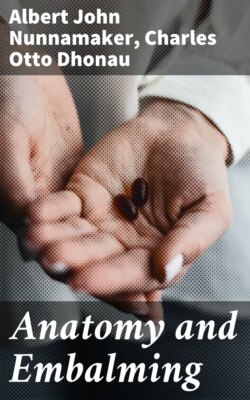Читать книгу Anatomy and Embalming - Charles Otto Dhonau - Страница 6
На сайте Литреса книга снята с продажи.
Guanch Embalming.
Оглавление—The Guanches with the Egyptians are the only nation among whom embalming had become national, and there exists in the process and mode of preservation of both such striking analogy, that the study of the Guanch mummies is, probably, the surest means of arriving at some positive notions of their origin and relationship. The details known of the mode of embalming among the Guanches will enlighten and complete the descriptions that ancient authors have left to us of the Egyptian processes. They were silent on desiccation in the act of mummification, but it is to be regarded as a simple omission on their part. This desiccation was continued during the seventy days of preparation, and it constituted the principle part of the process adopted.
The details that I am about to give are extracted from the work of M. Bory de Saint Vincent on the fortunate Isles.
“The arts of the Guanches were not numerous, the most singular without doubt is that of embalming. The Guanches preserved the remains of their relations in a scrupulous manner and spared no pains to guarantee them from corruption. As a moral duty each individual prepared for himself the skins of goats, in which his remains could be enveloped, and which might serve him for sepulture. These skins were often divested of their hair, at other times they permitted it to remain, when they placed indifferently the hair side within or without. The processes to which they resorted to make perfect mummies, which they named xaxos, are nearly lost.
With the Guanches, the embalmers were abject beings; men and women filled this employment respectively, for their sexes; they were well paid, but their touch was considered contamination; and all who were occupied in preparing the xaxos lived retired, solitary, and out of sight.
There were several kinds of embalming, and several different employments for those who had charge of it. When they had need of the services of the embalmers, they carried the body to them to be preserved, and immediately retired. If the body belonged to persons capable of bearing the expenses, they extended it at first on a stone table, the operator then made an opening in the lower part of the belly with a sharpened flint, wrought into the form of a knife and called tabona; the intestines were withdrawn, which other operators afterwards washed and cleaned; they also washed the rest of the body, and particularly the delicate parts, as the eyes, interior of the mouth, the ears, and the nails, with fresh water saturated with salt. They filled the large cavities with aromatic plants; they then exposed the body to the hottest sun, or placed it in stoves, if the sun was not hot enough. During the exposition they frequently endued the body with an ointment, composed of goats' grease, powder of odoriferous plants, pine bark, resin, tar ponce stone, and other absorbing material.
On the fifteenth day the embalming should be completely terminated; the mummy should be dry and light; the relatives send for it and establish the most magnificent obsequies in their power. They sew up the body in several folds of skin, which they had prepared while living, and they bind it with straps.
The kings and the grandees were besides placed in a case or coffin of a single piece, and hollowed out of the trunk of a juniper tree, the wood of which was held as incorruptible.
They then finally carried the xaxos, thus sewed and encased, to inaccessible grottoes consecrated to this purpose.
